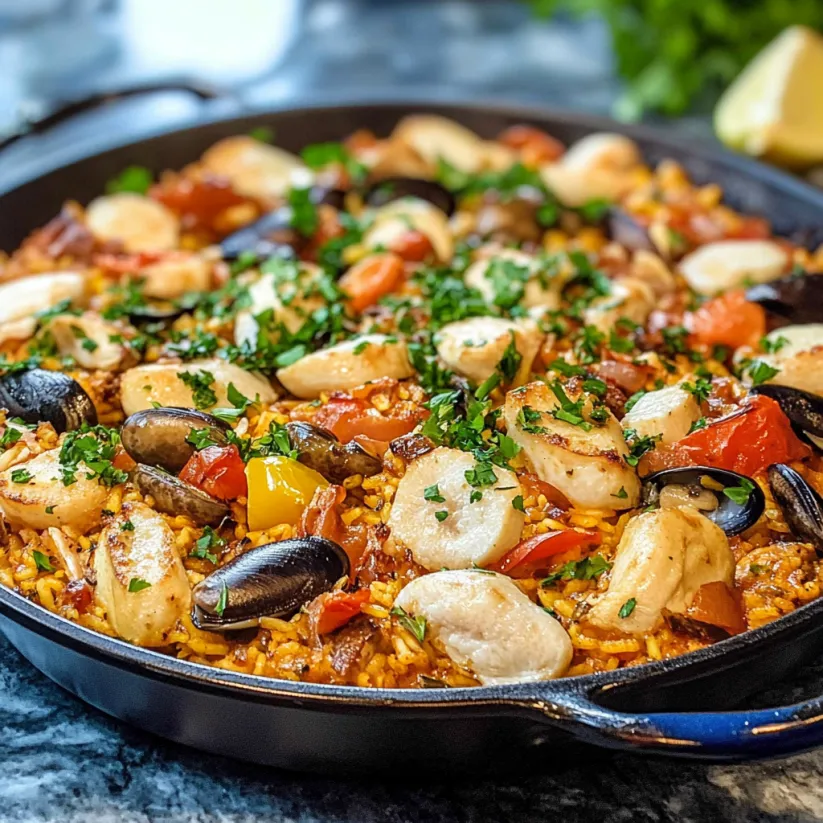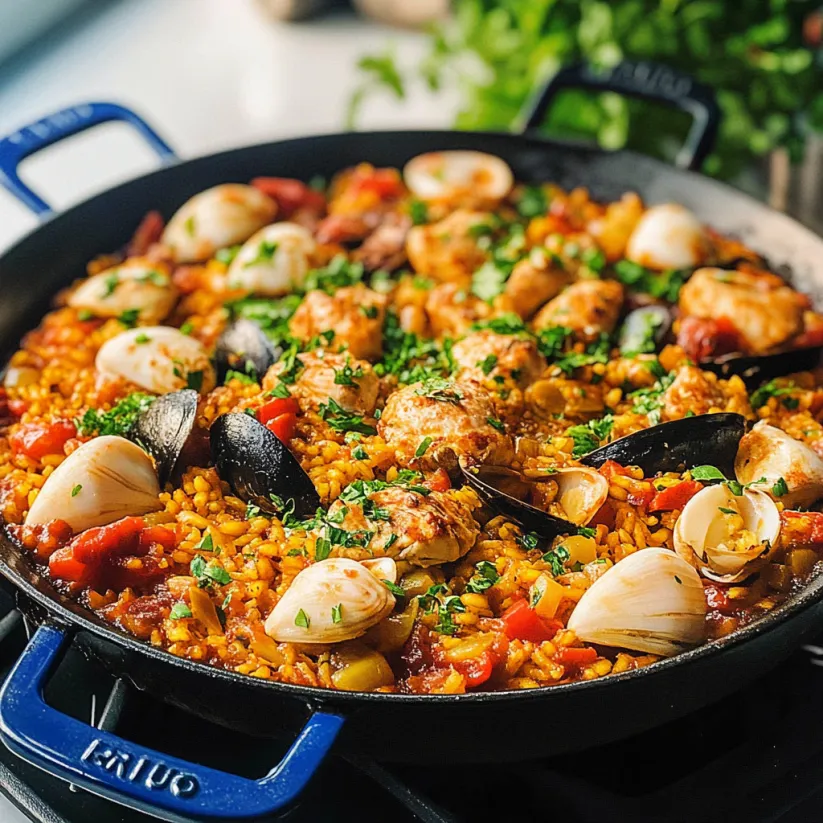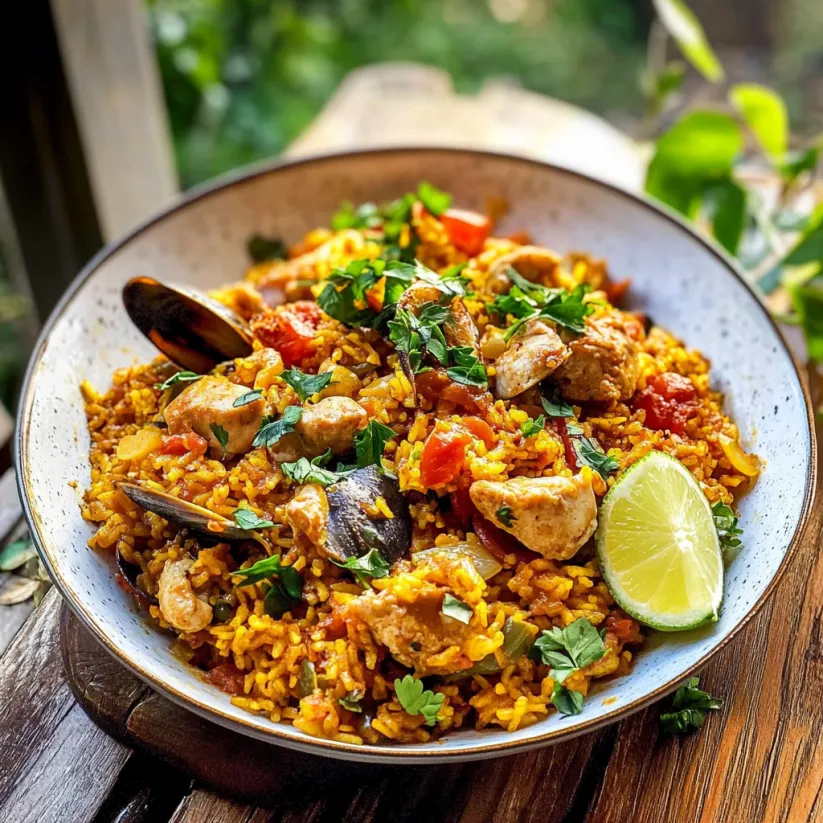 Save Pin
Save Pin
This authentic Spanish paella brings the vibrant flavors of coastal Spain right to your dinner table. The combination of tender chicken, spicy chorizo, and fresh seafood creates a show-stopping dish that's perfect for special occasions or weekend family dinners. I've refined this recipe over years of experimenting until it captures the true essence of traditional paella.
I first made this paella for my friends during a summer gathering after returning from Valencia, Spain. The moment I brought the colorful pan to the table, conversation stopped and everyone gathered around to admire it. Now it's my signature dish for celebrations.
Ingredients
- Olive oil provides the authentic Mediterranean foundation for developing flavors
- Boneless chicken thighs offer more flavor and tenderness than breast meat
- Chorizo sausage adds smoky depth and traditional Spanish character
- Arborio rice absorbs flavors beautifully while maintaining structure
- Fire roasted tomatoes bring sweet acidity that balances the rich proteins
- Saffron threads give the signature golden color and distinctive floral aroma
- Smoked paprika provides the quintessential Spanish flavor profile
- Fresh seafood including shrimp, mussels and scallops create the stunning presentation
- Fresh parsley and lemon wedges brighten the finished dish with essential freshness
Step-by-Step Instructions
- Build the Flavor Base
- Heat olive oil in a large paella pan over medium heat. Add chicken and chorizo pieces, seasoning with salt and pepper. Cook approximately 5 minutes until chicken is no longer pink. The rendered fat from the chorizo will infuse the oil with incredible flavor that seasons the entire dish.
- Develop the Sofrito
- Push meat to one side of the pan and add onions to the other half with a pinch of salt. Cook for 2 minutes until translucent and soft. Add garlic and cook one additional minute until fragrant. This aromatic base creates the foundation for authentic paella flavor.
- Toast the Rice
- Add arborio rice and fire roasted tomatoes, stirring well to coat every grain. Allow rice to cook in tomato juices for about 5 minutes until it begins to brown slightly on the bottom. This crucial step develops the first layer of flavor and prepares the rice to absorb the broth.
- Create the Broth Foundation
- Pour in vegetable or chicken broth along with hot sauce, smoked paprika, and saffron. Season with additional salt and pepper as needed. Cover with a large lid and simmer for about 15 minutes without stirring until most liquid is absorbed. The rice will be partially cooked.
- Add the Seafood
- Reduce heat to medium low. Arrange shrimp, mussels, and scallops across the top of the rice in a decorative pattern. Cover again and cook 10 minutes until shellfish opens. The seafood will release its juices into the rice, creating a concentrated ocean flavor.
- Finish and Serve
- Turn off heat and garnish with fresh parsley and lemon wedges. Allow ingredients to rest for a few minutes, then gently stir before serving to marry all flavors together. Make sure to scrape up the crispy bottom layer to distribute throughout each serving.
 Save Pin
Save Pin
Saffron is truly the heart of this recipe. I've tried making paella without it when I ran out once, and while still delicious, it lacked that distinctive floral aroma that transports you straight to Spain. My family immediately noticed the difference and now I always keep a small supply of high quality saffron in my spice cabinet.
The Secret to Perfect Paella
The traditional wide, shallow paella pan isn't just for aesthetics it serves a critical purpose. The large surface area allows the rice to cook in a thin layer, developing that coveted crispy bottom known as socarrat. If you don't have a dedicated paella pan, use your largest, widest skillet. The key is maximizing the surface area in contact with heat.
Making Paella Affordable
While traditional paella includes various seafood, you can create a delicious version without breaking the bank. Focus on one type of seafood rather than all three mussels offer the most flavor impact for the price. You can also make a equally delicious chicken and chorizo paella by simply omitting the seafood entirely. The saffron and technique are what truly make paella special.
Serving Suggestions
Paella is truly a one pot meal, but I like to serve it with a simple green salad dressed with sherry vinaigrette and crusty bread to soak up the flavorful juices. For beverages, a chilled Spanish Albariño wine or sangria complements the flavors beautifully. Serve the paella directly from the pan at the table for a rustic, communal dining experience that encourages conversation.
 Save Pin
Save Pin
Commonly Asked Questions
- → What type of rice works best for paella?
Arborio rice is recommended in this dish, which is an Italian short-grain rice that absorbs flavors well while maintaining its structure. Traditional Spanish paella rice varieties like Bomba or Calasparra can also be excellent alternatives as they absorb more liquid without becoming mushy.
- → Why shouldn't you stir paella while it's cooking?
Paella shouldn't be stirred during cooking because you want to develop the socarrat—the prized crispy golden crust that forms at the bottom of the pan. This layer is considered the mark of a well-made paella and provides incredible depth of flavor and textural contrast.
- → Can I make paella without saffron?
While saffron gives paella its distinctive flavor and golden color, you can substitute with a pinch of turmeric for color and additional smoked paprika for flavor if saffron is unavailable. However, the dish will miss some of the complex floral notes that only saffron provides.
- → What can I substitute for seafood in this paella?
If seafood isn't your preference, you can make a delicious land-based paella using just chicken and chorizo, perhaps adding vegetables like bell peppers, green beans, and artichoke hearts. For vegetarian options, substitute seafood with a variety of seasonal vegetables and mushrooms.
- → Do I need a special pan to make paella?
While a traditional wide, shallow paella pan is ideal for creating the signature crispy bottom layer and cooking ingredients evenly, you can use any large, wide skillet or shallow pan with a tight-fitting lid. Just ensure it has enough surface area to spread the rice in a thin layer.
- → How do I know when the paella is done?
The paella is done when the rice has absorbed most of the liquid but still maintains a slight firmness (not mushy), the seafood is cooked through (mussels and clams have opened), and you can detect a toasty aroma from the bottom crust forming. The total cooking time is typically about 25-30 minutes after adding the rice.
